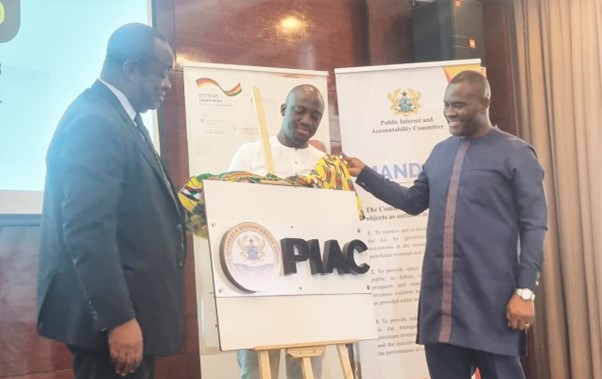
…as it unveils a new logo, redesigned website and new data dashboard
The Public Interest and Accountability Committee (PIAC) has said it is poised to strengthen its watchdog role over the use and management of petroleum revenue.
Since its establishment some 12 years ago, the Committee has used a number of communication channels to provide information to the citizenry. But given that PIAC’s professional profile has evolved over the period, it has now upgraded some of its communication tools while committing to step up its work.
The new change covers, namely, its corporate logo, website, and the addition of a data dashboard. These tools, it is understood, serve different purposes and communicate different aspects of PIAC’s work.
The Committee in its formative years chose the national Coat of Arms with its name beneath as its primary logo, reflecting its functional identity as a public institution.
However, it is argued that the use of this identity over the last 12 years has not communicated its purpose well, giving rise to the need for a rebrand.
Currently, it is difficult to associate PIAC with anything petroleum-related. This is because nothing in its name or current logo suggests it – thus compelling the Committee to explore avenues to make its role in the petroleum revenue management space noticeable to the public with a new identity.
The Vice Chairman of PIAC, Nasir Alfa Mohammed – speaking at a ceremony to introduce the visual changes, observed that in order to enhance its work, PIAC’s visibility is important in enabling the public to appreciate its impact.
“Although the Committee has been accustomed to using the Coat of Arms as its logo and a website to enhance our work, it has become necessary to enhance the Committee’s work even further,” he said.
It is against this background that he said with the latest developments there will be “an even better PIAC at its better peak working for the people of Ghana”.
Also, Committee Chairman Prof. Kwame Adom-Frimpong explained that PIAC through a lot of creative sessions settled on the new logo, which is consistent with current developments.
The new logo portrays the key elements which convey its mission while maintaining its legitimacy as a statutory institution. It signifies the industries, resources and revenues that the PIAC mandate prescribes, it was noted.
Prof. Adom-Frimpong averred that PIAC has ensured the efficient utilisation of petroleum revenues over the years. This new face, he said, therefore helps to solidify that role and present an institution whose mandate can be identified by its logo.
PIAC’s new corporate colours are Black, which signifies crude oil, and Gold which stands for wealth – as reflected in the new logo. The Committee’s modified logo shows that it plays a key role in ensuring that revenues from the production of crude oil are utilised in a manner that benefits all citizens.
Also, PIAC’s corporate website is one of the key tools it uses to engage the public with reports, statistics and activities it undertakes. Following its use over the period and feedback from the public, the website has now undergone redesigning to align it with public expectations and in line with changing technological trends. The redesigned website is a reflection of the Committee’s attempt to intensify its public outreach and improve the visibility of PIAC and its work, as well as take feedback.
It is expected that the Data Dashboard will help provide easy access to information on Ghana’s petroleum sector to the public.
The dashboard comprises an interactive platform that illustrates statistics on oil and gas production, receipts and how these receipts are allocated and distributed – and it is hoped will serve as a hub for all required petroleum statistics.
The Deputy Minister of Finance, John Kuma, also speaking at the ceremony underscored the importance of the Committee’s work in helping to ensure transparency and accountability in use of revenues from the country’s natural resources.
He assured of government’s continuous support to work with the Committee, saying that every criticism made should be aimed at making the system better; and therefore it always looks forward to the PIAC’s work.









